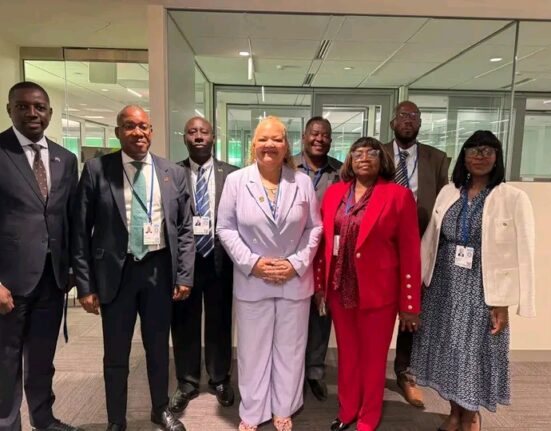Income inequality remains one of the most pressing issues faced by many countries around the world, including Namibia. One of the key tools used to measure income inequality is the Gini coefficient, a statistical measure that helps understand the distribution of income or wealth within a nation. In this article, we will delve deep into the Gini coefficient, its application to Namibia, and explore the current state of income inequality in the country, its causes, and the policy measures aimed at addressing this critical issue.
What is the Gini Coefficient?
The Gini coefficient, or Gini index, is a measure of inequality in a distribution, such as income or wealth. It ranges from 0 to 1, where:
- A Gini coefficient of 0 indicates perfect equality (everyone has the same income or wealth).
- A Gini coefficient of 1 signifies maximal inequality (one person or household has all the income or wealth, while others have none).
In practice, the Gini coefficient is most commonly used to gauge income inequality. A higher Gini coefficient indicates higher levels of inequality, while a lower value suggests a more equal distribution of income.
The Gini coefficient can be calculated using data on the distribution of income across households or individuals within a country. It is often presented in statistical reports and is a key indicator used by policymakers, economists, and researchers to analyze economic disparities and plan interventions.
Understanding Income Inequality in Namibia
Namibia is one of the most economically unequal countries in the world. According to the World Bank and other international organizations, the country has consistently ranked high on the Gini coefficient scale, indicating significant income inequality. While Namibia has made considerable strides in improving the overall economy, inequality persists, posing challenges to social cohesion and economic stability.
As of recent reports, Namibia’s Gini coefficient is estimated to be 0.59, one of the highest globally. This high level of inequality indicates a stark contrast between the richest and poorest segments of the population. To better understand the implications of this figure, it’s important to explore the root causes of income inequality in Namibia and its social and economic consequences.
Key Factors Contributing to Income Inequality in Namibia
Several factors contribute to the pronounced income inequality seen in Namibia. These include historical, social, and economic aspects that have influenced wealth distribution over the years.
1. Historical Legacy of Apartheid
Namibia’s history under colonial and apartheid rule has had long-lasting effects on its economic structure. The apartheid system of racial segregation and discrimination created deep economic divides, limiting access to resources, education, and economic opportunities for the majority black population. Even after Namibia gained independence in 1990, the wealth and opportunities were still largely concentrated among the white minority.
The policies of apartheid created a two-tier society where economic power was centralized in the hands of a small, wealthy elite, while the majority of Namibians lived in poverty or had limited access to quality education, land, and jobs. The legacy of these policies continues to contribute to Namibia’s high levels of inequality, as many of the inequalities in wealth and education persist across generations.
2. Unequal Access to Education and Employment
Access to education is a significant factor in determining income inequality. In Namibia, education remains highly unequal, with poorer communities often having limited access to quality education. While the government has made efforts to improve access to education post-independence, disparities persist between urban and rural areas, as well as among different ethnic groups.
The lack of access to quality education directly impacts employment opportunities, particularly for those in disadvantaged areas. Consequently, the inability to access well-paying jobs perpetuates income inequality. In urban areas like Windhoek, there are higher rates of formal employment with better wages, while rural areas continue to experience higher levels of poverty and unemployment.
3. Economic Structure and Unemployment
Namibia’s economy is heavily reliant on a few key sectors such as mining, agriculture, and fisheries. These sectors, while important, have limited capacity to absorb large numbers of workers, particularly those without specialized skills. This results in high unemployment rates, especially among the youth and those with lower levels of education.
The agricultural sector, which employs a significant portion of the population, is largely informal and vulnerable to external shocks like droughts and climate change. This informal economy often offers low wages, leading to further income disparity. Additionally, many Namibians work in seasonal or low-paying jobs that provide little opportunity for upward mobility.
4. Wealth Concentration in the Hands of a Few
Another contributing factor to Namibia’s income inequality is the concentration of wealth in the hands of a small percentage of the population. A significant portion of the country’s wealth is concentrated within a few industries, particularly mining and land ownership. This means that individuals and corporations in these sectors have access to the lion’s share of economic resources, while the majority of the population remains disadvantaged.
The concentration of wealth is further exacerbated by limited economic diversification and high barriers to entry in sectors like mining, banking, and large-scale agriculture. As a result, wealth accumulation is often hereditary, passed down through generations, leaving little opportunity for economic mobility among the majority of the population.
5. Rural-Urban Divide
There is a stark contrast between urban and rural areas in terms of income levels, employment opportunities, and access to services. Urban centers like Windhoek, Swakopmund, and Oshakati offer more diverse job opportunities and higher wages compared to rural areas, where subsistence farming and informal employment dominate. The rural-urban divide has resulted in a situation where a large proportion of rural dwellers, particularly those in communal areas, live below the poverty line.
6. Social Assistance and Welfare Policies
Although Namibia has made progress in addressing poverty through social grants, the social assistance system remains limited. Social welfare programs in Namibia, such as the Child Grant and Old Age Pension, have helped reduce poverty for many vulnerable groups, but they are not sufficient to significantly narrow the income gap. Furthermore, the lack of targeted interventions for the working poor in informal sectors means that inequality persists despite social programs.
The Impact of High Income Inequality
The consequences of high income inequality in Namibia are far-reaching and affect various aspects of society and the economy:
1. Social Instability
High levels of inequality often lead to social unrest, as large sections of the population feel excluded from the benefits of economic growth. In Namibia, the gap between rich and poor has created tensions, particularly among marginalized communities, leading to protests and calls for greater economic reform.
2. Limited Economic Growth
Economic inequality can also hinder overall economic growth. When a large portion of the population lacks the purchasing power to participate in the economy, the potential for sustainable development is reduced. Lower-income households tend to spend a higher percentage of their income on basic needs, leaving little for investment or savings, which hampers long-term growth.
3. Health and Education Disparities
Income inequality has a direct impact on access to healthcare and education. In Namibia, poorer households are less likely to afford quality healthcare, leading to poor health outcomes. Similarly, the unequal access to education results in lower levels of human capital, which further perpetuates the cycle of poverty and inequality.
4. Political Polarization
Inequality often leads to political polarization, as different social groups may feel that their interests are not being represented. This can result in political instability and a lack of consensus on national issues, further exacerbating the divide between rich and poor.
Addressing Income Inequality in Namibia: Policy Measures and Solutions
To address the high levels of income inequality in Namibia, a multi-faceted approach is required. The government and other stakeholders must work together to implement strategies that promote more equitable economic growth.
1. Improving Access to Education
Investing in education, particularly in rural and underserved areas, is crucial for reducing inequality. Improving the quality of primary, secondary, and tertiary education will give Namibians the skills they need to participate in higher-paying, formal employment.
2. Job Creation and Economic Diversification
Expanding sectors beyond mining, agriculture, and fisheries will help create more job opportunities and reduce dependence on a few industries. Encouraging entrepreneurship, supporting small and medium-sized enterprises (SMEs), and promoting the development of the tourism, manufacturing, and technology sectors can foster more inclusive growth.
3. Progressive Taxation and Wealth Redistribution
A progressive taxation system, where the wealthy contribute a higher percentage of their income to the state, could help fund social programs that benefit the poor. Additionally, policies aimed at wealth redistribution, such as land reform, can help reduce the concentration of wealth.
4. Strengthening Social Safety Nets
Expanding and improving social assistance programs, such as unemployment benefits and grants for vulnerable groups, will help reduce the immediate effects of inequality. However, these programs should be coupled with long-term strategies aimed at addressing the root causes of inequality.
5. Promoting Rural Development
Investing in rural areas through infrastructure development, better access to healthcare and education, and support for small-scale farmers can help reduce the rural-urban divide and improve income equality across the country.
Income inequality remains a significant challenge for Namibia, with the Gini coefficient providing a useful tool for measuring and understanding the extent of this inequality. Despite progress in various sectors, the historical legacy of apartheid, unequal access to education, and concentrated wealth continue to perpetuate inequality in the country. However, with targeted policies focused on education, job creation, and wealth redistribution, Namibia can address the root causes of income inequality and work towards a more inclusive and prosperous future for all its citizens.













